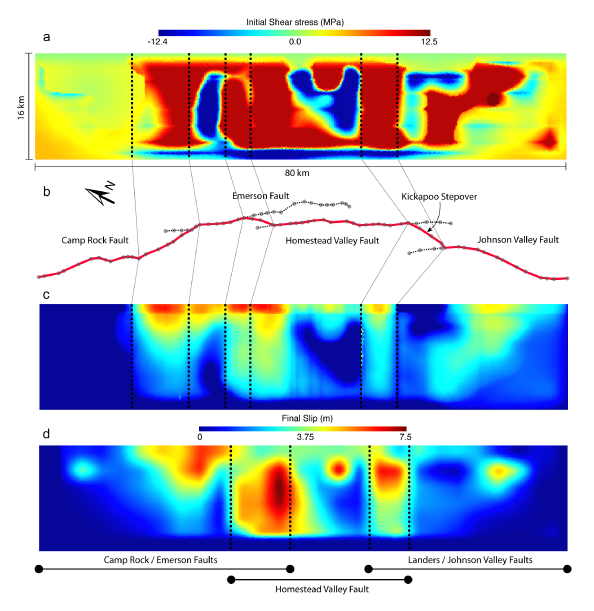Current Work
Three-dimensional dynamic rupture modelling of the 1992 Landers earthquake
We applied the DGCrack method (Tago et al., 2012) to study some aspects of the 1992 Landers earthquake considering a realistic fault-system geometry. Our simulation deploy a 1D layered medium and took advantage of the hp-adaptivity by refining the unstructured mesh around the rupture surface and simultaneously adapting the elements sizes to resolve 0.5 Hz waves everywhere in the simulation domain (Figure 1). 48.6% of the 4.48 millions tetrahedra in the mesh are P1 elements and belong to the CPML slab, while the rest (51.4%) are P2 elements and discretize the entire physical domain. Our source model is based on a slightly modified version of the heterogeneous initial shear stress determined by Peyrat et al. [2001] on a planar fault from the final slip found by Wald and Heaton [1994]. Since both we had to reduce fracture energy by a factor of two with respect to the earthquake model proposed by Peyrat et al. [2001] to allow rupture propagation along the entire non-planar fault system, and obtained a significant seismic moment underestimation (see Figure 2), we conclude that generating realistic pre-stress conditions for the Landers earthquake from its final slip distribution requires considering the fault-system geometry. For more details see Tago et al., 2012.
Figure 1 The 1992 Landers earthquake fault-system geometry embedded in a 1D layered medium (L1, L2 and L3) and discretized with an hp-adaptive tetrahedral mesh (see Tago et al., 2012).
Movie 1 Shear stress (MPa) spontaneous evolution over the rupture surface.
Movie 2 Slip rate (m/s) spontaneous evolution over the rupture surface.
Figure 2 Landers earthquake fault parameters displayed in a single plane with major geometrical barriers (i.e., kinks) indicated with black dotted lines. (a) Initial shear stress used in this study; (b) discretization (grey dots) of the Landers earthquake fault system taken from the Community Fault Model for Southern California [Plesch et al., 2007]. The red line indicates the fault geometry used in this study (Figure 1); (c) final slip produced by the DGCrack dynamic rupture simulation; and (d) final slip and fault discretization for the 1992 Landers earthquake found by Wald and Heaton [1994] (see Tago et al., 2012).

